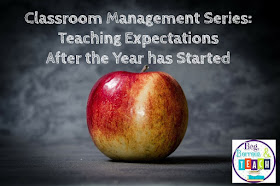Are you looking for some time-tested, evidence-based ways to enhance your classroom management? Would you like to reinforce your existing classroom management techniques or start over from scratch? Then my post on enforcing expectations after the year has started is for you!
This is the first post in my Classroom Management Series, so I wanted to tackle something that I hear about a lot from ALL teachers, whether they are seasoned or brand new:
Let me share my strategies/answers to these questions with you!
This is the first post in my Classroom Management Series, so I wanted to tackle something that I hear about a lot from ALL teachers, whether they are seasoned or brand new:
- How do I reinforce my classroom expectations midway through the year?
- Can I wipe the slate clean and start over if things aren't going well?
Strategy #1: Start the New Quarter Like it's a New Year
I’ve had veteran teachers tell me they start off new grading periods and returns from breaks as “first days of school.” There are several reasons why this is ideal:
- Even the most well-behaved classes need a refresher course on behavior expectations after holiday breaks or report cards.
- This is the perfect time to throw out any procedures that aren't working for you or your class.
- Seasoned teachers know that they can change, reset, and modify expectations ANY time.
Give an end of quarter reflection/survey so you can gather some information from them and then implement changes based upon the results.
Reflection survey questions should be specific to what happened in the past quarter:
How do you feel about your performance and what can you improve?
What is one thing you would like to see different in the new quarter?
New Quarter Actionable Tip 2: Create a New Classroom Constitution
How do you feel about your performance and what can you improve?
What is one thing you would like to see different in the new quarter?
New Quarter Actionable Tip 2: Create a New Classroom Constitution
Liken the need to revamp expectations to amending the Constitution. Not everything works how you'd thought!
Create a new class constitution based on what worked/didn't work.The responses to your reflection survey can guide this process. You might ask students to write what success looks like in class, how the teacher should communicate success, and what rewards and consequences they would prefer. Together, you can then write out an agreement that is signed by the students, parents, and teacher.
New Quarter Actionable Tip #3: Choose the Top Three Problems and Explicitly Teach/Reteach Your Procedures for Dealing With These Problems
One of the most important classroom procedures that I rely on constantly is SLANT. When I say “SLANT”, students know to close their devices, put their pencils down, stop talking, and look at me.
Below is an example SLANT poster from Whooo’s Ready to Teach? blog.
Strategy #2: Be Honest About What Went Wrong
If you started off too nice, just be honest with them. The conversation might go something like this:
"I am concerned that the original management plan isn't working. Students aren't in the right position to be the best learners they could be and we need to change some things to help you be more successful." Then, implement the new rules.
Strategy #3: Talk to Your Colleagues
It might be time to involve your grade-level counterparts to come up with expectations, consequences, and incentives for the entire grade level. The new quarter is a great time to introduce these.
Strategy #3: Talk to Your Colleagues
It might be time to involve your grade-level counterparts to come up with expectations, consequences, and incentives for the entire grade level. The new quarter is a great time to introduce these.
Strategy #4: Keep Building Relationships With Students
Nothing helps to manage a classroom more than talking to kids one on one privately, encouraging them to step up and be a leader and extricate themselves from the talkers and disrupters, in conjunction with a classroom plan. It helps them know you care too.
Strategy #5: New Seating Chart
You know the allies and axis now. Reward the Middle, replace the distractions
Seating Chart Actionable Tip 1: Seat Students in a Boy-Girl Pattern
While this might seem counter intuitive, especially in middle or high school, it really does cut down on the talking.
Seating Chart Actionable Tip 2: Change the Desk Arrangement
If the problem is too much taking, try rows or a horseshoe setup. If you need to encourage talking, try pods of 3-4.
Strategy #6: Reach Out to Parents
Start by identifying three students in each class who are the most disruptive, call their parents and tell them what's going on, and ask how you can work with them to improve their child’s' behavior and attitude. If need be, focus on three more kids whose parents need to be contacted.
Join me next time, when I continue my behavior management series with "How to be a Leader, Not a Boss".
Join me next time, when I continue my behavior management series with "How to be a Leader, Not a Boss".



No comments:
Post a Comment